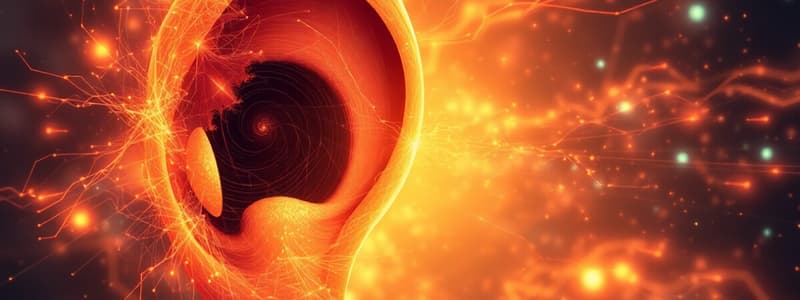Podcast
Questions and Answers
What is the primary function of the tympanic membrane?
What is the primary function of the tympanic membrane?
- Filtering out noise generated within the body.
- Transferring sound from the air to the ossicles. (correct)
- Protecting the ear from excessive vibrations.
- Amplifying pressure on the oval window.
Why is impedance matching important for the function of the tympanic membrane?
Why is impedance matching important for the function of the tympanic membrane?
- To minimize reflection and maximize transmission of sound. (correct)
- To equally balance reflection and transmission of sound.
- To prevent any transmission of sound into the middle ear.
- To maximize reflection and minimize transmission of sound.
Based on the provided intensity ratios, what is the approximate percentage of sound wave intensity reflected at the eardrum?
Based on the provided intensity ratios, what is the approximate percentage of sound wave intensity reflected at the eardrum?
- 1%
- 100%
- 99% (correct)
- 50%
What is the role of the ossicles (hammer, anvil, and stirrup) in the middle ear?
What is the role of the ossicles (hammer, anvil, and stirrup) in the middle ear?
The pressure on the oval window is amplified compared to the pressure on the eardrum, which is caused by what?
The pressure on the oval window is amplified compared to the pressure on the eardrum, which is caused by what?
What is the function of the middle ear at high sound levels?
What is the function of the middle ear at high sound levels?
What is the role of the cochlea in the inner ear?
What is the role of the cochlea in the inner ear?
Which of the following structures separates the scala vestibule from the scala media in the inner ear?
Which of the following structures separates the scala vestibule from the scala media in the inner ear?
What is the primary function of the pinna in the auditory system?
What is the primary function of the pinna in the auditory system?
The auditory canal enhances the sensitivity of the ear to certain frequencies due to its ability to act as a resonator. Based on the information provided, which frequency range benefits most from this resonance?
The auditory canal enhances the sensitivity of the ear to certain frequencies due to its ability to act as a resonator. Based on the information provided, which frequency range benefits most from this resonance?
What is the primary role of the tympanic membrane (eardrum) within the auditory system?
What is the primary role of the tympanic membrane (eardrum) within the auditory system?
Which of the ranges represents the region where the ear has the 'best sensitivity'?
Which of the ranges represents the region where the ear has the 'best sensitivity'?
Which of the following is NOT a function of the auditory canal?
Which of the following is NOT a function of the auditory canal?
The auditory system can be described as a series of conversions. Which of the following accurately describes the complete sequence of these conversions, starting from the initial sound wave?
The auditory system can be described as a series of conversions. Which of the following accurately describes the complete sequence of these conversions, starting from the initial sound wave?
An object is lodged part way down the ear canal. Which of the following is most likely to occur?
An object is lodged part way down the ear canal. Which of the following is most likely to occur?
The formula to calculate the first resonant frequency (F1) of the ear canal could be expressed as $F_1 = \frac{V}{4L}$, where V is the velocity of sound and L is the length of the canal. If someone has a slightly shorter auditory canal than average, how would this affect their F1?
The formula to calculate the first resonant frequency (F1) of the ear canal could be expressed as $F_1 = \frac{V}{4L}$, where V is the velocity of sound and L is the length of the canal. If someone has a slightly shorter auditory canal than average, how would this affect their F1?
Flashcards
The Ear
The Ear
System that detects sound, aids in balance, and determines body position.
Ear's Function
Ear's Function
The process where the ear transforms weak mechanical waves into electrical signals, which are then sent to the brain.
Auditory System
Auditory System
Catches and amplifies sound using mechanical components, converts to into electrical signals through sensory components, and decodes to analyze electrical signals in the auditory cortex of the brain.
Ear Sections
Ear Sections
Signup and view all the flashcards
Outer Ear
Outer Ear
Signup and view all the flashcards
Outer Ear Parts
Outer Ear Parts
Signup and view all the flashcards
Pinna Functions
Pinna Functions
Signup and view all the flashcards
Auditory Canal
Auditory Canal
Signup and view all the flashcards
Tympanic Membrane Function
Tympanic Membrane Function
Signup and view all the flashcards
Eardrum Reflection
Eardrum Reflection
Signup and view all the flashcards
Middle Ear Bones
Middle Ear Bones
Signup and view all the flashcards
Middle Ear Amplification
Middle Ear Amplification
Signup and view all the flashcards
Middle Ear Functions
Middle Ear Functions
Signup and view all the flashcards
Inner Ear Function
Inner Ear Function
Signup and view all the flashcards
Hearing Portion of Inner Ear
Hearing Portion of Inner Ear
Signup and view all the flashcards
Inner Ear Chambers
Inner Ear Chambers
Signup and view all the flashcards
Study Notes
- The lecture covers the physics of the ear and hearing.
- Topics include the hearing system, parts of the ear (outer, middle, and inner), hearing loss (deafness), and hearing tests using audiometers.
Hearing System
- A hearing system consists of a sound source, a detector, and a receiver.
- The ear is the organ that detects sound, aids in balance, and is part of the auditory system.
- The ear converts weak mechanical waves in the air into electrical pulses in the auditory nerve.
- The auditory system has a mechanical component for catching and amplifying sound by the ear.
- A sensory (electrical) system converts mechanical pulses into electrical signals passed to the brain.
- The brain decodes and analyzes electrical nerve signals in the auditory cortex.
Auditory System Structure
- The ear is divided into the outer, middle, and inner ear.
Outer Ear
- It collects and directs sound waves to the tympanic membrane via a canal.
- Consists of the pinna, auditory canal, and tympanic membrane (eardrum).
- The pinna collects sound, acting as a funnel to amplify it and provide directional information.
- The auditory canal is a tube from the outer to the middle ear, about 2.5cm long and 0.7cm in diameter.
- Functions of the auditory canal include:
- Protection of the eardrum from shocks.
- Prevention of harmful items from entering with hair and wax.
- Sound amplification by acting as a resonator, producing standing waves.
Outer Ear and Standing Waves
- A closed cylindrical air column produces resonant standing waves at a fundamental frequency and odd harmonics.
Standing Waves in the Ear Canal
- Resonance will enhance ear sensitivity in the 2000-10000 Hz range, with best sensitivity in the 2000-4000 Hz region.
Tympanic Membrane
- A cone-shaped piece of skin about 10 mm in width, separating the outer ear from the middle ear.
- Very sensitive, it vibrates with slight pressure variations.
- The primary function is to transfer sound from the air to the ossicles in the middle ear.
- Acoustic signals travel along the ear canal and strike the eardrum, resulting in reflection and transmission.
- Hearing sensitivity reflection should be minimized, and transmission maximized.
- Incoming wave intensity mostly reflects indicating bad impedance matching and hearing loss.
Middle Ear
- Central part of the ear behind the eardrum.
- Contains the hammer, anvil, and stirrup, which transmit vibrations to the oval window of the inner ear.
- Functions of the middle ear bones:
- Acts as a lever system, amplifying pressure on the oval window by approximately 22 times.
- The force on the oval window (fo) is about 1.5 times the force on the eardrum (fm).
- The area of the oval window (Ao) is approximately 15 times smaller than the area of the eardrum (Am).
- Filters out noise generated in the body.
- Protects from excessive vibrations via a less-efficient vibration mode at high sound levels.
- Acts as a lever system, amplifying pressure on the oval window by approximately 22 times.
Inner Ear
- Transforms the energy of compressional waves into nerve impulses for transmission to the brain.
- The hearing portion of the inner ear is the cochlea, connected to the stirrup (stapes).
- The Cochlea is a snail-shaped structure in which fluid waves produces.
- Divided into three fluid-filled chambers: vestibular, middle, and tympanic.
- Reissner membrane separates the scala vestibule from the scala media.
- Basilar membrane separates the scala media from the scala tympani.
- Two types of sensory hair cells (inner and outer) along the basilar membrane.
- The sensory hair cells respond to frequency (pitch) and are covered by the tectorial membrane.
- Sound energy causes basilar membrane vibration, shearing hair cells on the tectorial membrane.
- Inner ear contains electrical charges that result in neural impulses which travel along the auditory nerve to the brain.
- High frequency sounds produce the greatest motion of the basilar membrane near the oval window.
- Low frequency sounds produce the greatest motion of the basilar membrane farthest from the apex.
- This results in electrical pulse production and transmission along the organ of Corti.
Hearing Loss (Deafness)
- May be caused by changes at any auditory system level.
- Conduction hearing loss involves impairments in sound transmission through the external or middle ear to the cochlea.
- Nerve hearing loss occurs with the destruction of hair cells or damage to the auditory nerve.
- Central hearing loss happens due to brain damage.
- Conductive hearing loss affects the passage of sound between the eardrum and the inner ear.
- Nerve hearing loss is where there is damage to the hair cells in the cochlea.
Hearing Test (Audiometer)
- Electronic instrument used to measure hearing.
Studying That Suits You
Use AI to generate personalized quizzes and flashcards to suit your learning preferences.




